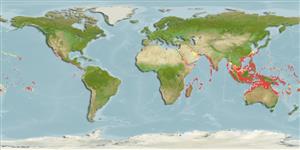Common names from other countries
>
Eupercaria/misc (Various families in series Eupercaria) >
Scaridae (Parrotfishes) > Sparisomatinae
Etymology: Calotomus: Greek, kalos, kallos = beautiful + Greek, tomos = section, cut (Ref. 45335).
More on authors: Quoy & Gaimard.
Environment: milieu / climate zone / depth range / distribution range
Ecologia
marino associati a barriera corallina; distribuzione batimetrica 1 - 72 m (Ref. 86942). Tropical; 30°N - 30°S
Indo-West Pacific: Kenya to at least Delagoa Bay in Mozambique, and east to the Marshall and Tonga Islands. Presence in Somalia to be confirmed (Ref. 30573).
Length at first maturity / Size / Peso / Age
Maturity: Lm 10.5 range ? - ? cm
Max length : 30.0 cm TL maschio/sesso non determinato; (Ref. 48636)
Spine dorsali (totale) : 9; Raggi dorsali molli (totale) : 10; Spine anali: 3; Raggi anali molli: 9; Vertebre: 25. General body color when fresh is greenish brown with scales finely flecked with pale; shade of white ventrally (belly sometimes dull rose or yellowish). Across the chin, 2 irregular dull reddish bars interspaced by white or yellow; upper opercular margin with a diffused dark spot. Hyaline pectorals with a yellowish flush; pelvic fins hyaline except for numerous small white spots and some reddish blotches. Flexible dorsal spines. Area circumscribed by pectoral fin unspotted. Lateral line interrupted (scales usually 19 + 7, occasionally 19 + 6).
Found in coastal bays and deep lagoons (Ref. 48636). Inhabits seagrass beds or dense beds of algae. Well-camouflaged and easily overlooked (Ref. 48636). Feeds on these or the associated epiphytes. Caught nets and other types of artisanal gear.
Life cycle and mating behavior
Maturities | Riproduzione | Spawnings | Egg(s) | Fecundities | Larve
Spawning at Aldabra occurs above grassflats on falling tides; protogynous hermaphroditism with both primary & secondary males occurring in the atoll's population has also been reported (Ref. 1875).
Bruce, R.W. and J.E. Randall, 1985. A revision of the Indo-West Pacific parrotfish genera Calotomus and Leptoscarus (Scaridae: Sparisomatinae). Indo-Pac. Fish. (5):32 p. (Ref. 525)
IUCN Red List Status (Ref. 130435)
CITES (Ref. 128078)
Not Evaluated
Threat to humans
Harmless
Human uses
Pesca: commerciale; Acquario: Commerciale
Strumenti
Special reports
Download XML
Fonti Internet
Estimates based on models
Preferred temperature (Ref.
115969): 24.5 - 28.9, mean 27.6 (based on 838 cells).
Phylogenetic diversity index (Ref.
82804): PD
50 = 0.5312 [Uniqueness, from 0.5 = low to 2.0 = high].
Bayesian length-weight: a=0.01202 (0.00752 - 0.01922), b=3.13 (2.99 - 3.27), in cm Total Length, based on LWR estimates for this species & (Sub)family-body (Ref.
93245).
Trophic level (Ref.
69278): 2.0 ±0.00 se; based on food items.
Resilienza (Ref.
120179): Alto, tempo minimo di raddoppiamento della popolazione meno di 15 mesi (K=1.00).
Fishing Vulnerability (Ref.
59153): Low vulnerability (18 of 100).
